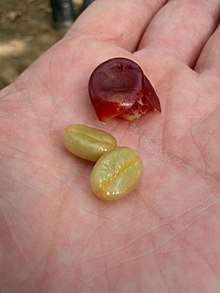Coffee cherry tea
Coffee cherry tea is a herbal tea made from the dried skins[1] of the coffee fruit. Often, it is more than the skins that are used, and include the dried berries (or "cherries") of the coffee plant that remain after the coffee beans have been collected from within. It is also known as cascara, from the Spanish cáscara, meaning "husk". It is different from cáscara sagrada tea, a powerful plant-based laxative derived from Rhamnus purshiana, which is native to the Pacific Northwest.
Coffee cherry tea is a common drink in some coffee-growing nations, notably Bolivia, and, as the variant qishr, in Yemen. Outside of these traditional uses, the coffee fruit is usually considered a wasted byproduct of the coffee production process.[2] However, increasing demand for cáscara from large U.S.-based coffee chains has, in some cases, led to the dried husks fetching higher prices than the coffee beans.[3]
It is commonly consumed in Bolivia, where it is referred to as sultana, and is made of sun-dried and lightly toasted coffee cherries. It may also be mixed with sticks of cinnamon. It is also called "the poor man's coffee", and "the coffee of the Army".[4] It is believed that cáscara tea was consumed in Yemen even before the form of coffee we know today.[5]
Coffee cherries contain caffeine, as does the tea, though while the tea is popularly understood to have a high level of caffeine,[6] it actually only has about a quarter the caffeine levels of coffee.[7][8] Cascara is often used as a laxative and is known to be high in antioxidants.[9][10] The taste of coffee cherry tea is different from coffee, and has been described as somewhat sweet and cherry flavored, surprisingly pleasant.[11]
Brewing
Brewing guidelines are not standardized, but 20 grams per liter of water,[12] or approximately 5 grams per cup (8 oz, 240 ml)[11] is suggested. When the coffee cherry tea is ground and classified to loose tea industry standard size, one teaspoon per 6 ounces of water, steeped for 5 minutes are the standard brewing instructions.
Proper brewing yields a dark red tea; brew time guidelines range from 4 minutes[12] to 7 or 8 minutes.[11]
Availability
As of 2017, cascara is regularly sold in a small number of cities in the United States, including Washington D.C.,[13] New York City,[14] Boston,[15] Raleigh,[16] Los Angeles,[17] and Seattle.[18]

Starbucks Coffee and Blue Bottle Coffee have both featured cascara-based drinks on their seasonal menus, including a "cascara latte" and a "cascara fizz", respectively.[3]
See also
- Coffee-leaf tea
- Qishr, a Yemeni drink using coffee husks
References
- ↑ What is Cascara?, Fresh cup, 28. März 2017
- ↑ "Welcome to Lazy Bear Tea!". Lazy Bear Tea. Retrieved 2018-02-18.
- 1 2 "Coffee Waste Is Now Fetching a 480% Premium Over Coffee Itself". Retrieved 2018-05-24.
- ↑ "coffeed.com • View topic - Ever Eat A Coffee Cherry?". www.coffeed.com.
- ↑ Dave,, Eggers,. The monk of Mokha (First ed.). New York. ISBN 1101947314. OCLC 987983540.
- ↑
- ↑ "Cascara and caffeine". 30 August 2013.
- ↑ "Beverage derived from the extract of coffee cherry husks and coffee cherry pulp". Kraft Foods R&D Inc (Munich). 16 November 2010.
- ↑ "Cascara: Uses, Side Effects, Interactions, Dosage, and Warning". www.webmd.com. Retrieved 2018-06-20.
- ↑ "ORAC Values: 2018 Food Antioxidant Database | Superfoodly". www.superfoodly.com. Retrieved 2018-06-20.
- 1 2 3 (Dane 2009)
- 1 2 (Hoffman 2008)
- ↑ "Commonwealth Joe May Have Scraped Together the Next 'Hot' Drink". Eater DC. Retrieved 2018-04-26.
- ↑ "Home". Nomad Trading Co.
- ↑ "Home". Lazy Bear Tea.
- ↑ "Home". Slingshot Coffee Co.
- ↑ "About". Venice Cold Brew.
- ↑ "menu". Ada's technical books.
External links
- Coffee, Tea ... or Both?, Ana Dane, 13 November 2009
- What is Cascara?, Ciummo Brenna, May 20, 2014, Fresh Cup magazine.
- Video of Cascara brewing, James Hoffman, 5 November 2008, from Square Mile Coffee Roasters